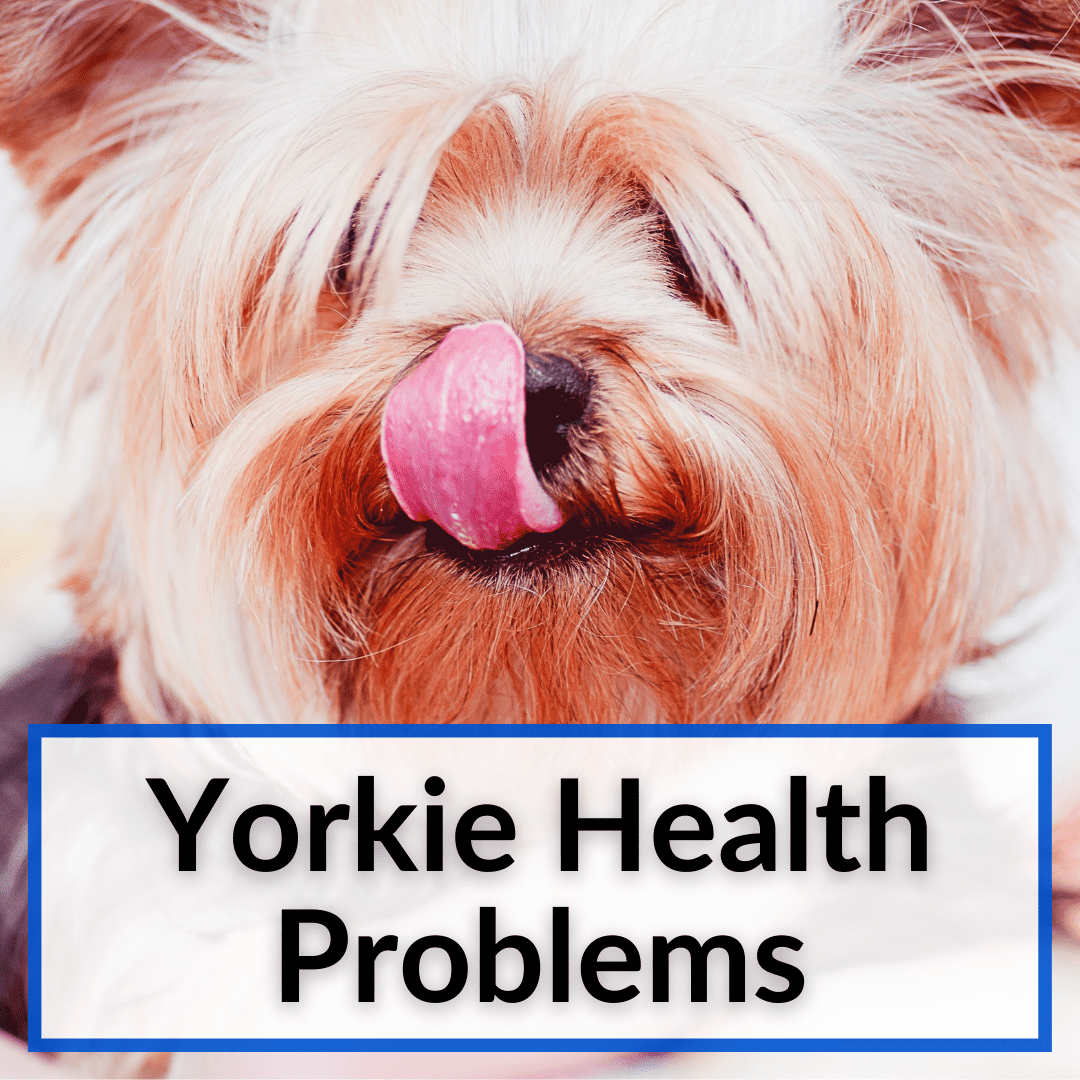
They don’t get sick nearly as often as some other breeds.
But they are at higher risk of certain inherited, congenital or acquired defects.
Most are fixable if they are detected early and some are completely preventable.
The key is knowing how to protect your pup, and learning how to recognize the signs of the most common yorkie health problems.
Keep reading for details on the main yorkie health issues to look out for, including common symptoms and treatment options.
Contents
Yorkie Health Issues: Common Medical Problems
The following health problems are common in Yorkshire terriers. We will cover the major symptoms, so you can learn to recognize when you dog might be suffering from one of these issues and get it to a vet for a proper diagnosis and (hopefully) early treatment.
Hypoglycemia
This is a condition that comes up due to an abnormally low level of blood sugar. It is a common health defect that affects mostly Yorkshires and other small dog breeds.

Yorkshires are at higher risk of suffering from hypoglycemia during the first five months of their life. But adults are also at risk, especially during pregnancy or if they have liver disease.
This health problem affects major brain function and motor skills. There are many reasons why your dog could be having hypoglycemia. Some of the common causes include stress and insufficient nutrients. You need to know what and how much yorkies eat.
Common Signs Of Hypoglycemia
- Low energy levels
- Fainting
- Drowsiness
- General body weakness.
- Shaking
- Coma
- Tremors
- Confused behavior
Diagnosis And Treatment
In older dogs, a veterinarian could perform certain tests in order to detect hypoglycemia. This includes:
- X-rays
- Urinalysis
- Blood sugar level tests
- Serum biochemistry tests
Once your dog has been diagnosed with hypoglycemia, the very first homemade treatment is rubbing honey on its gums.
You can also use warm heating pads to increase your dog’s body temperature. Place the heating pads around the puppy’s body.
These two remedies will help to stabilize your yorkie’s condition. Once you get to the vet, he or she will administer a warm dextrose solution through injection.
Afterward, the doctor will give you instructions to feed your dog small portions of food throughout the day. These foods should be rich in fat, complex carbohydrates and proteins.
Retinal Dysplasia
Retinal dysplasia is an inherited health issue that could lead to vision problems in the long term. It causes abnormal retinal development. This, in turn, leads to defects in the functionality of the eyeballs.
Breeders always avoid breeding a yorkie with this problem, since the offspring could carry on the condition.

When your dog has retinal dysplasia, there is a layer of tissue that covers the backside of the dog’s eyeball. Unfortunately, the retina is responsible for the dog’s vision. Damage on this tissue leads to visual problems, worst case, blindness.
Common Signs Of Retinal Dysplasia
In mild cases, you can’t even tell that your dog is experiencing any visual problems. To detect the severity of this condition, your dog might need to undergo a visual exam. When the Yorkie’s vision is affected, some signs will be evident:
- Bumping into objects
- Stumbling
- Confusion
As discussed earlier, this condition is usually inherited from the dog’s parents. However, in some cases, it could develop after eye trauma or an eye infection. Ensure that you take your dog for examination on a yearly basis for early diagnosis.
Diagnosis And Treatment
Unfortunately, there is no cure for this disorder as of yet. Dogs that have very mild cases of this disease can go on living just fine without any difficulties.
In extreme cases, the dog will still survive, but may end up losing its vision, either partially or fully. You will need to train your dog to adjust its vision if it has this condition.
Even if your dog has a serious case, you don’t need to worry too much about your Yorkshire terrier. They have an incredible sense of smell and hearing. It is much easier for them than it is for us to compensate for their loss of sight with their excellent sense of smell and hearing.
If your dog gets to the point of complete blindness, you can make its life easier by placing its toys, food, and water in the same place every time.
Make sure its routines remain constant, including the routes you take during walks. If you need to introduce any changes, make sure you do so gradually.
Collapsed Trachea
This condition is mostly common in miniature dog breeds, like yorkies. A collapsed trachea is a condition that involves the narrowing of the trachea.

I know you are probably wondering how this happens. This condition is caused by a softening of the cartilages that hold together the trachea. It could be due to an inherited genetic weakness.
But the most common reason is from the use of a collar. With such small dogs, the trachea rings could collapse inward if you pull too hard on the leash. It can also happen over time, even if you do not ever pull too hard.
The best way to prevent this is to not use collars on your yorkie. You should strongly consider using a harness instead. A harness will always give you better control when training the dog. At the same time, the best yorkie harnesses will not hurt the dog’s trachea.
Common Signs Of Collapsed Trachea
- Gagging sounds
- Noisy breathing
- Coughing
- Troubled breathing
Most of these symptoms show up when the dog exercises in hot, humid air. When the condition is too severe, the dog’s gums may end up turning blue and it could faint.
Diagnosis And Treatment
For the diagnosis part of a Yorkie tracheal collapse, the veterinarian performs an examination and takes an X-ray. The treatment is very gradual. It needs to be done step by step.
Going slow helps reduce the trauma and in turn, open the airways in order to enhance normal breathing. If the situation gets too bad, surgery may be required.
In fact, there is a higher chance for your dog to survive with surgical intervention. During the healing process, ensure that you keep your pup away from any kind of respiratory irritant, like smoke or perfume.
Luxating Patella
Luxating patella is also commonly known as kneecap dislocation. It is a very common congenital health problem, especially in yorkies. You can easily identify a dog that has this kneecap dislocation disorder, since the kneecap pops out of the knee joint in a strange manner.

This knee dislocation disorder is a birth defect that results in improper development of the tissues and tendons around the kneecap. This makes the kneecap unstable.
If your yorkie has this condition, you will notice that its kneecap either remains out or even moves in and out alternatively.
If the problem escalates without any treatment, your dog could suffer extreme issues with its legs. In worst-case scenarios, it could end up with zero motor functions in the affected leg.
Common Signs Of Luxating Patella
A suffering from the luxating patella, might only show one symptom, but could also have all of them. These symptoms come and go. You might seem them for a while and then suddenly, they are gone.
The most common sign is that your yorkie will yelp, especially when the kneecap slips out of place. Your puppy may still be able to play even if the kneecap is out of place. But after the kneecap slips, you are likely to notice the following reactions in your dog:
- An odd walk, like skipping
- Limping
- The dog may avoid bending the hind legs
Diagnosis And Treatment
The luxating patella condition is easily diagnosed using an X-ray or even an ultrasound. After that, the dog is treated until the condition improves. Cases that lie between minor and moderate are best treated with at least 6 weeks of bed rest.
Alongside the compulsory bed rest, there are anti-inflammatory medications to help your dog with the healing process. This treatment works well and ensures that your dog is completely healed. The only problem is that once a knee slips, the likelihood of it happening again is very high.
For that reason, you want to help your yorkie build stronger muscles, especially around the knees. This helps prevent such an occurrence from happening again. Walking uphill is one of the best exercises that you can do to achieve this.
All in all, if the condition keeps on recurring, surgery might be the only option. The good thing is that this surgery has a success rate of 90%.
Portosystemic Shunt
This an inherited condition that primarily affects dogs. It is an abnormality in the portal vein, which is the vein that brings blood to the liver for the purposes of cleansing.

When a dog has a portosystemic shunt, the blood tends to bypass the liver, which means it flows throughout the dog’s body without ever being filtered.
This is incredibly dangerous, because the blood ends up accumulating toxins. These toxins end up being deposited in organs like the brain, lungs, heart and more, poisoning them.
Common Signs Of A Portosystemic Shunt
- Loss of appetite
- Diarrhea
- Drooling
- Poor coordination
- Inability to learn
- Weak development of muscles
- Sporadic throwing up
When the condition enters the late stages, you may notice the following signs in your dog:
- Blindness
- Seizures
- Coma
Diagnosis And Treatment
This health problem is diagnosed through blood tests. The vet looks for high levels of serum or bile, or even a large increase in blood ammonia. This test is mainly effective after the dog has had a large meal.
The most effective treatment of this condition is surgery. However, if your dog cannot undergo surgery, you should not panic.
The dog is still treatable with antibiotics as well as a dietary restriction for proteins. Also, you can administer medication that helps to reduce the production of blood ammonia.
Legg-Perthes Disease
This is a condition that primarily affects the hip bone joint. It is a common issue with Yorkshire Terriers especially.

When your dog has this health problem, there is inadequate blood circulation in the hip region of the dog. This results in the femur weakening, and eventually collapsing.
In addition, the cartilage that surrounds the femur could become malformed or cracked. This is a condition that usually happens when a puppy is still very young, generally between 5 and 8 months.
Common Signs Of Legg-Perthes Disease
- Limping
- Agony
- Lame legs
Diagnosis And Treatment
You need x-rays of the hip joints to diagnose this health problem. But even then, diagnosis is not always easy.
Changes in bones can happen very slowly, If an x-ray is taken very early into the disease, the bone could seem perfectly normal.
That is why vets recommend a second set of x-rays exactly 3 weeks after the first. This helps to monitor the changes in the bone.
For treatment, you should consider surgery in order to remove both the head and the neck of the damage femoral bone.
After the removal of the damaged parts of the femur, the vet uses the ligaments that interweave all across the hip joint to create a false joint.
The good news for us yorkie owners is that Yorkshire Terriers recover from this condition better than most larger dog breeds. With time, the dog retains normal use of the leg and its Yorkie back leg problems go away.
Yorkie Health Problems: Final Thoughts
Yorkshire Terriers don’t get sick as easily as other breeds, but they are prone to a number of health problems. The ones mentioned above are the most common. But don’t worry, most of these conditions are treatable with either surgery, antibiotics, or exercise. And often all three.
The key to keeping your yorkie healthy is regular check ups and a healthy lifestyle. Ensure that your pup always gets plenty of exercise and enjoys a healthy diet of high quality dog food and nutritious treats.
Of course, there are also plenty of other health problems that can affect Yorkies. We have articles about many of them in our sectio on “Health.” A good example is our post on Yorkie Black Skin Disease.
Leave a Reply